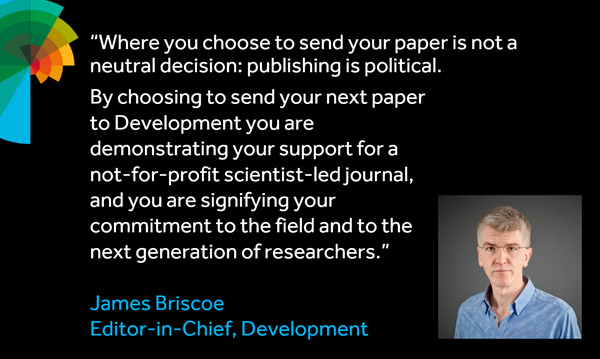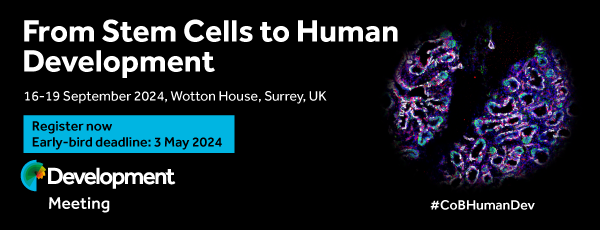Issues
-
Cover image
Cover Image

Cover: Stage 17 Drosophila melanogaster embryo (ventral view) showing Elav (green; neuronal nuclei), Spalt (yellow; subset of neuron and muscle nuclei), BP102 (red; CNS axons), Eve (magenta; subset of CNS nuclei, and ring of nuclei around anal pad), HRP (grey; neuronal cell bodies and axons) and DAPI (blue; nuclei) staining. The image was taken by Connie Rich (University of Cambridge, UK) at the 2014 Woods Hole MBL embryology course and was chosen by readers of the Node (http://thenode.biologists.com).
- PDF Icon PDF LinkTable of contents
- PDF Icon PDF LinkIssue info
IN THIS ISSUE
MEETING REVIEW
Heartbreak hotel: a convergence in cardiac regeneration
Summary: This Meeting Review summarises the key advances presented at the recent Company of Biologists workshop on Transdifferentiation and Tissue Plasticity in Cardiovascular Rejuvenation.
REVIEW
Plant regeneration: cellular origins and molecular mechanisms
Summary: This Review article summarises how plants control various types of regeneration and discusses how developmental and environmental constraints influence these regulatory mechanisms.
STEM CELLS AND REGENERATION
Trop2 marks transient gastric fetal epithelium and adult regenerating cells after epithelial damage
Summary: Trop2, a marker of gastric fetal glandular epithelium grown ex vivo, is re-expressed upon injury in adult regenerative cells together with a partial fetal-like genetic program.
Spinal motor neurons are regenerated after mechanical lesion and genetic ablation in larval zebrafish
Summary: Regeneration of spinal motor neurons following mechanical lesion or genetic ablation occurs at the expense of oligodendrogenesis and is promoted by the innate immune system.
Asialoglycoprotein receptor 1 is a specific cell-surface marker for isolating hepatocytes derived from human pluripotent stem cells
Highlighted article: Expression of cell surface protein ASGR1 can be used to isolate a subpopulation of more mature, homogenous hepatocyte-like cells derived during differentiation from pluripotent stem cells.
RESEARCH ARTICLES
A quantitative analysis of growth control in the Drosophila eye disc
Highlighted article: A quantitative analysis of growth dynamics of the Drosophila eye primordium reveals that the area growth rate declines in inverse proportion to the increasing total area.
Centrosomal protein CP110 controls maturation of the mother centriole during cilia biogenesis
Highlighted article: CP110 promotes the assembly of subdistal appendages and ciliary vesicle docking during cilia formation in vivo, thereby facilitating mammalian organogenesis.
Retinoid signaling controls spermatogonial differentiation by regulating expression of replication-dependent core histone genes
Highlighted article: Upregulation of replication-dependent core histone genes by retinoic acid signaling contributes to spermatogonial differentiation in mice.
Lhx2 is a direct NF-κB target gene that promotes primary hair follicle placode down-growth
Summary: Loss of LHX2 replicates a subset of the phenotypes seen in embryos with reduced NF-κB signaling, while exogenous TGFβ2 can rescue this effect in Lhx2 knockout skin explants.
An anterior signaling center patterns and sizes the anterior neuroectoderm of the sea urchin embryo
Summary: FoxQ2 activates an anterior signaling center that expresses the secreted Wnt modulators sFRP1/5 and Dkk3 – essential components of the Wnt network governing anterior-posterior neuroectoderm patterning.
RGMB and neogenin control cell differentiation in the developing olfactory epithelium
Summary: Ablation of RGMB expression, or of its receptor neogenin, leads to increased progenitor cell numbers and affects cell fate choice in the developing mouse olfactory epithelium.
Restricting calcium currents is required for correct fiber type specification in skeletal muscle
Summary: Developmental splicing of CaV1.1 restricts calcium currents in skeletal muscle, which are critical for activity-dependent regulation of fiber type specification and the prevention of mitochondrial damage.
Semaphorin 3A is a retrograde cell death signal in developing sympathetic neurons
Summary: A Sema3A-initiated apoptotic signaling complex regulates the apoptosis of sympathetic neurons during their period of naturally occurring cell death.
Loss of Bmi1 causes anomalies in retinal development and degeneration of cone photoreceptors
Summary: Bmi1 is required to prevent postnatal degeneration of cone photoreceptors and bipolar neurons, while BMI1 inactivation in human embryonic stem cells impairs cone terminal differentiation.
aura (mid1ip1l) regulates the cytoskeleton at the zebrafish egg-to-embryo transition
Summary: The zebrafish maternal-effect gene aura encodes Mid1ip1l, which is involved in cytoskeletal rearrangements during the egg-to-embryo transition.
NRPB3, the third largest subunit of RNA polymerase II, is essential for stomatal patterning and differentiation in Arabidopsis
Summary: RNA polymerase II subunit NRPB3 interacts with stomatal bHLH transcription factors FAMA and ICE1, connecting the stomatal development pathway to the general transcription machinery.
Differential regulation of meristem size, morphology and organization by the ERECTA, CLAVATA and class III HD-ZIP pathways
Summary: Three pathways converge to regulate the balance between meristem size, morphology and organization in the Arabidopsis shoot apical meristem.
DRACULA2 is a dynamic nucleoporin with a role in regulating the shade avoidance syndrome in Arabidopsis
Summary: DRACULA2, an Arabidopsis nucleoporin with an SAS regulatory role, participates in nucleocytoplasmic transport and also appears to have a transport-independent role in controlling shade-induced gene expression.
CORRECTION
ARTICLES OF INTEREST IN OUR OTHER JOURNALS
From Journal of Cell Science
Call for papers: Uncovering Developmental Diversity

Development invites you to submit your latest research to our upcoming special issue: Uncovering Developmental Diversity. This issue will be coordinated by our academic Editor Cassandra Extavour (Harvard University, USA) alongside two Guest Editors: Liam Dolan (Gregor Mendel Institute of Molecular Plant Biology, Austria) and Karen Sears (University of California Los Angeles, USA).
Choose Development in 2024

In this Editorial, Development Editor-in-Chief James Briscoe and Executive Editor Katherine Brown explain how you support your community by publishing in Development and how the journal champions serious science, community connections and progressive publishing.
Journal Meeting: From Stem Cells to Human Development

Register now for the 2024 Development Journal Meeting From Stem Cells to Human Development. Early-bird registration deadline: 3 May. Abstract submission deadline: 21 June.
Pluripotency of a founding field: rebranding developmental biology

This collaborative Perspective, the result of a workshop held in 2023, proposes a set of community actions to increase the visibility of the developmental biology field. The authors make recommendations for new funding streams, frameworks for collaborations and mechanisms by which members of the community can promote themselves and their research.
Read & Publish Open Access publishing: what authors say

We have had great feedback from authors who have benefitted from our Read & Publish agreement with their institution and have been able to publish Open Access with us without paying an APC. Read what they had to say.



